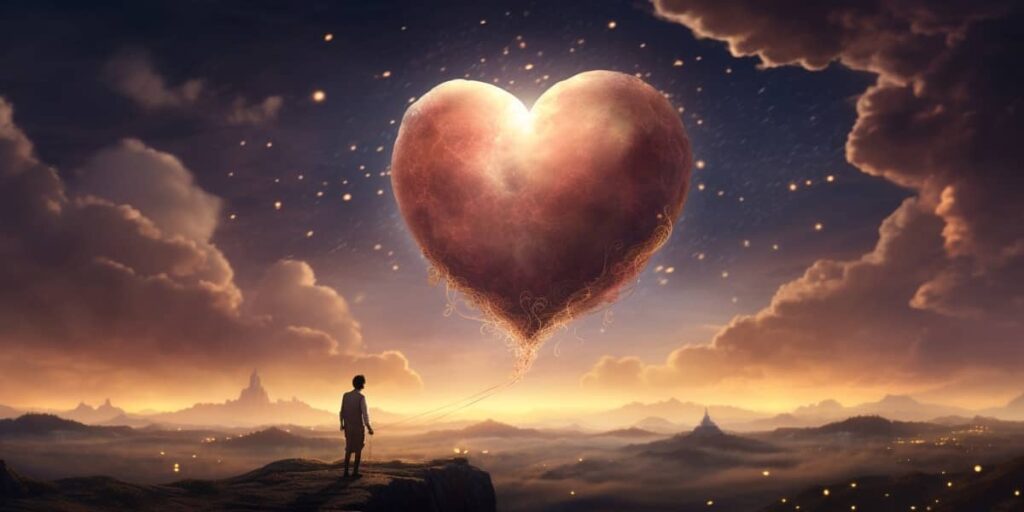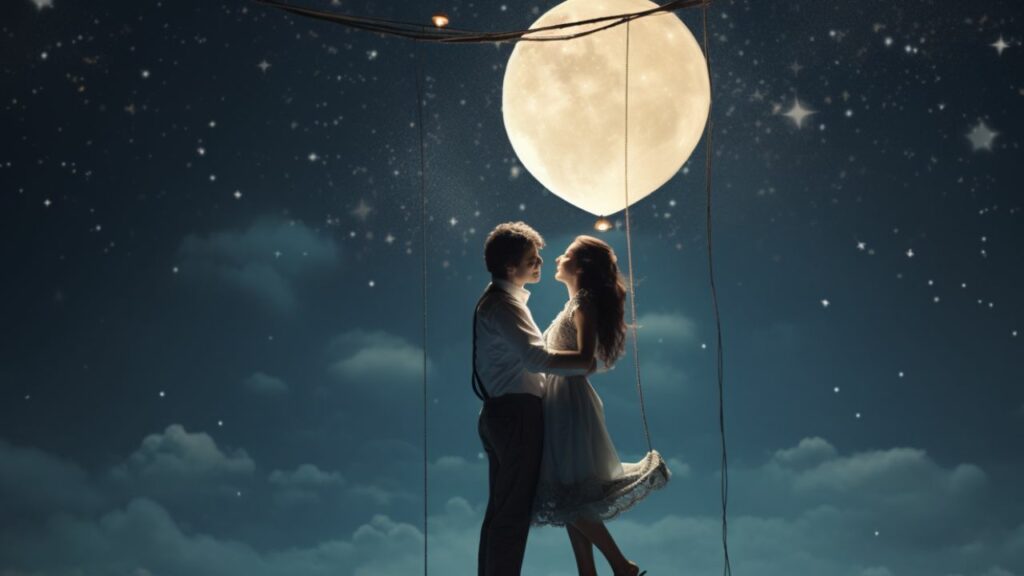“I love you to the moon and back” is a phrase we’ve all heard, used, or had spoken to us at some point. It’s a sentiment that resonates deeply in our culture and hearts; it captures an immeasurable amount of affection in just a handful of words. But have you ever stopped to consider its origin or ponder over what it truly means?
As someone who’s fascinated by language and expressions, I’ve delved into this intriguing phrase to shed light on its roots and significance. The phrase “I love you to the moon and back,” though simple at face value, carries profound connotations about the depth of love one can hold for another.
The journey takes us through children’s literature, popular culture, science, and even astrology – proving that love knows no bounds. In fact, it travels approximately 238,855 miles (the distance between Earth and Moon) – and back! So buckle up as we explore the cosmic dimensions of this endearing expression.
Understanding the Phrase ‘Love You to the Moon and Back’
Have you ever thought about what it truly means when someone says, “I love you to the moon and back”? I’ll delve into this intriguing expression, letting you in on its deeper meanings.
Originating from a children’s book called ‘Guess How Much I Love You’ by Sam McBratney, this phrase has won over hearts worldwide. It’s a charming way of quantifying an immeasurable emotion—love. The protagonists, two hares—one big and one small—are trying to outdo each other in expressing how much they care for one another. When Little Nutbrown Hare says he loves Big Nutbrown Hare “right up to the moon,” the latter responds with “…and back.”
But let’s dissect this further. The average distance between Earth and the moon is approximately 238,855 miles. So if we’re talking literally here, that’s quite a journey! However, as most of us understand it—this phrase isn’t about literal distances at all.
The essence behind these words lies in their figurative meaning—it encapsulates the idea of loving someone beyond measure. It essentially means that your love for them extends beyond any physical boundaries or limitations—it’s boundless and infinite.
When used colloquially, people often use this phrase as a grand declaration of love—to communicate that their affection is so vast it could span astronomical distances!
Remember though, while it’s easy to get caught up in its romanticized notion—the true value of “I love you to the moon and back” lies not merely in saying it but meaning it wholeheartedly every single time.
Cultural Impact of ‘Love You to the Moon and Back’
Let’s dive right into the heart of it. The phrase “love you to the moon and back” is more than just a sweet sentiment shared between loved ones. It’s evolved into a cultural phenomenon that permeates various aspects of our society.
Firstly, this catchy saying has found its way into numerous literary works. From children’s books like Sam McBratney’s “Guess How Much I Love You”, which popularized the phrase, to romance novels and poems, writers often use it to convey deep affection and boundless love.
Secondly, pop culture hasn’t been immune to its charm either. Numerous songs feature these heartfelt words in their lyrics or titles. For instance, Savage Garden’s 1996 hit single “To The Moon & Back” undeniably capitalized on this phrase’s emotional resonance.
Thirdly, let’s look at consumer products. A quick internet search will reveal thousands of items bearing this slogan – from home decor pieces like wall art and cushions, to personal accessories such as jewelry and clothing items. Clearly, marketers understand the appeal of these words in reaching out to consumers’ hearts (and wallets).
Finally, social media platforms are awash with posts containing #loveyoutothemoonandback. This popularity shows how we’ve embraced this expression digitally too.
So here we have it: an expression born out of an endearing tale has managed not only to tug at our heartstrings but also become deeply embedded in global culture over time.
Influence on Popular Music and Literature
If you’ve swayed to the rhythm of pop culture, you’ll have noticed how “Love You to the Moon and Back” has seeped into our collective artistic consciousness. It’s made its mark in music and literature, shaping the way we perceive love.
Let’s take a look at some notable examples from popular music. Australian band Savage Garden released a track titled “To The Moon & Back” back in 1996 – it was a hit! Then there’s country darling Dolly Parton who crooned “I Will Always Love You” with lyrics echoing this sentiment. Even contemporary artists like Luke Bryan have added their spin with songs like “Crash My Party”. If that isn’t enough, Taylor Swift’s recent album ‘Lover’ features lyrics akin to this expression.
Moving over to literature, I’ve found countless authors who’ve infused this phrase into their work. Children’s books especially seem smitten with it – Sam McBratney’s ‘Guess How Much I Love You’ being an adored example. Here’s what else caught my eye:
- A novel by Amelia Kahaney plays with this theme.
- Lisa Schroeder’s YA novel ‘I Heart You, You Haunt Me’.
- Jackie French Koller uses it as a book title!
It seems clear that creative minds have found fertile ground in the rich soil of “love you to the moon and back”. Whether through song or prose, they’ve painted vivid pictures of love that are as boundless as space itself.
What fascinates me is not just its popularity but also its enduring appeal. It speaks volumes about our shared human experience – after all, who hasn’t yearned for a love so deep it could cross galaxies? In essence, whether through song lyrics or narrative arcs in novels, everyone seems eager to ride on Apollo 11’s coattails!
Interpretations of ‘Love You to the Moon and Back’
“I love you to the moon and back” – it’s a phrase we’ve all heard, but what does it really mean? Let’s delve into this beloved expression.
First off, let’s consider its literal meaning. The distance to the moon from Earth is roughly 238,855 miles. So when someone says they love you “to the moon and back”, they’re essentially saying their love for you encompasses almost half a million miles! That’s quite an impressive way to quantify one’s feelings.
But don’t get me wrong. It doesn’t mean that their affection will reduce if scientists discover a new route reducing this distance by half! It’s more about going an incredible length or making enormous efforts for someone you dearly care about.
Beyond literal interpretation, this phrase also has a deep emotional resonance. Love isn’t something we can easily measure or quantify, yet with this expression, one tries to capture its vastness and depth. It signifies limitless affection—a profound bond that spans immeasurable distances.
And here’s another interesting tidbit: This phrase gained popularity after being used in Sam McBratney’s children book Guess How Much I Love You. In the story, Little Nutbrown Hare tells his father how much he loves him—“right up to the moon.” His dad responds by saying he loves him “right up to the moon—and back.”
To sum up,
- ‘Love you to the moon and back’ implies vast amount of love
- Indicates willingness go great lengths for loved ones
- Signifies limitless affection
- Gained prominence through children literature
In essence, when people say they love you “to the moon and back”, they’re trying to express an incomprehensible degree of love—one so large it transcends physical distances.
‘Love You to the Moon and Back’ in Art
I’ve always found it fascinating how artists use common phrases and expressions to create profound pieces of art. One such phrase that’s been a popular muse is “love you to the moon and back”. It’s a sweet sentiment that has inspired many creative minds, producing an array of visual masterpieces.
Let’s take a stroll through some galleries where this phrase has left its romantic imprint. For instance, artist Adrian Brannan beautifully captures this saying with her acrylic painting titled “To The Moon And Back”. In it, two whimsical characters share an intimate moment under the gleaming moon – a testament to their limitless love.
Next up on our list is printmaking artist Cathy Eliot. She employs text in her artworks often as central elements. Her piece “Moon Love” features the enchanting phrase elegantly written against a backdrop of celestial bodies – it’s truly out of this world!
Meanwhile, sculptor Richard Becker offers his take on expressing infinite affection through his bronze sculpture “To Infinity”. It showcases two figures reaching for a stylized moon while standing on an infinity symbol, cleverly articulating that their love knows no bounds.
Here are few more noteworthy mentions:
- Victoria Velozo’s mixed media artwork “Moon Heart”
- Stella Chang’s paper carving art “Cosmic Love”
- Joe Webb’s collage “Moonglow”
Each one carries its own unique interpretation of loving someone ‘to the moon and back’, proving that art really does imitate life. Whether it’s through paintings, sculptures or prints, these artists have successfully encapsulated this timeless expression into their creations, adding new dimensions to our understanding of love.
Usage in Everyday Conversations
I’ve got to tell you, “love you to the moon and back” isn’t just a phrase found on greeting cards or home decor. It’s become an integral part of our everyday language, used frequently to express deep affection for someone. From parents whispering it to their children at bedtime, lovers saying it during heartfelt moments, or friends signing off their messages with it—it’s everywhere.
You might be wondering how it became so popular. Well, it traces back to Sam McBratney’s classic children’s book “Guess How Much I Love You”. The phrase was spoken by Little Nutbrown Hare in a cute game of one-upmanship with Big Nutbrown Hare about who loved whom more. The idea stuck and has since been adopted into popular culture across the globe.
But what does this idiom actually mean? Essentially, it conveys immeasurable love—a love that goes beyond earthly limitations. When you say “I love you to the moon and back”, you’re essentially telling someone that your love for them is as vast as the distance between Earth and its closest celestial neighbor—around 238,855 miles—and back round trip! That’s quite a declaration!
Here are few instances where this phrase can be used:
- When expressing deep affection for a significant other: “Hey honey, just wanted to remind you—I love you to the moon and back.
- As a comforting affirmation between parent and child: “Remember my little munchkin—I love you to the moon and back.”
- Among best friends sharing deep sentiments: “Bestie—you know I love you to the moon and back, right?”
And there we have it—the rich tapestry of how “love you to the moon and back” permeates our everyday conversations. It’s much more than just words; rather, it’s an expression of profound emotion that connects us all.
‘Love You to the Moon and Back’ as an Expression of Endearment
You’ve probably heard it before, that sweet phrase: “I love you to the moon and back”. But have you ever stopped to think about its meaning? It’s more than just a whimsical piece of sentiment; it has a deeper resonance that testifies the intensity of one’s affection.
To say “I love you to the moon and back” is essentially declaring your love in astronomical proportions. Imagine traveling 238,900 miles to reach the moon from Earth, then doubling it for the return journey. That’s roughly 477,800 miles! So when someone tells you they love you to the moon and back, they’re expressing a degree of affection so vast it could span nearly half a million miles.
This expression isn’t just popular in everyday conversation. It also holds sway in literature and pop culture:
- It first gained wide recognition from Sam McBratney’s children’s book “Guess How Much I Love You”, where Little Nutbrown Hare expresses his love for Big Nutbrown Hare using this phrase.
- In recent years, we’ve seen this phrase emblazoned across social media posts, greeting cards, nursery wall art – even as lyrics in songs like Taylor Swift’s “Moonlight”.
But why does this expression hold such emotional power? Well, there are several reasons:
- The moon has long been associated with romance and mystery – think star-crossed lovers gazing at the same lunar spectacle despite being worlds apart.
- Secondly, it’s hyperbolic nature serves as an effective tool for communicating intense emotions.
- Lastly, its inherent charm lies in its simplicity – no fancy words or grand gestures needed.
In essence, “love you to the moon and back” is an endearing way of saying: I can’t quantify my feelings for you because they’re off-the-charts. It’s a love that surpasses ordinary boundaries and reaches for the stars, quite literally. So next time someone tells you they love you to the moon and back, know that it’s an extraordinary expression of affection – one that transcends mere words.
Conclusion: The Impact of Saying ‘I Love You to the Moon and Back’
Saying “I love you to the moon and back” isn’t just a mere statement. It’s a proclamation that carries considerable weight in our relationships. This phrase signifies a deep, boundless affection that surpasses any quantifiable measure.
Expressing such profound emotion has numerous effects on both the sender and receiver. When I say it, I’m not merely passing along words; I’m conveying my heartfelt feelings. It tells my loved ones how much they mean to me, creating an emotional connection that’s as vast as the distance between Earth and its lunar companion.
The impact of this phrase goes beyond just fostering strong relationships, though. It can also have positive psychological effects for both parties involved. By expressing such limitless love:
- We feel happier due to increased levels of serotonin – the body’s ‘feel good’ hormone.
- Our stress level decreases as oxytocin – often referred to as the ‘love hormone’ – increases.
- We experience improved self-esteem knowing we are deeply loved.
But it’s not just about what happens in our hearts and minds; there are tangible benefits too:
| Benefits | Description |
|---|---|
| Improved communication | Expressing deep emotions can pave the way for open dialogue in relationships |
| Stronger bond | Such statements foster trust, promoting a stronger relationship bond |
| Emotional security | Knowing someone loves us unconditionally provides emotional stability |
To sum everything up, saying “I love you to the moon and back” is more than just a sweet sentiment or catchy phrase from a children’s book – it’s an expression with real influence over our emotions and relationships. So don’t shy away from using it when you genuinely feel it because its impact can be more profound than you might think!



